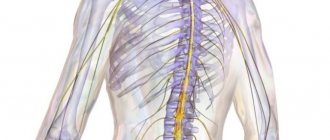MRI is an advanced, informative diagnostic method that allows you to study in detail the deep structures of the body. Detailed visualization of internal tissues occurs through the use of the principle of nuclear magnetic resonance. The doctor recommends undergoing a study to identify the causes of neurological syndromes and disorders in the body. Many patients are interested in whether MRI of the brain is harmful and how often such examinations can be performed.
Principle of the MRI method
To understand whether it is dangerous to do an MRI of the brain, it is important to remember the principle of operation of the device. The device, which looks like a large capsule, creates and maintains a magnetic field of varying strength. The most powerful devices create a field with a strength of up to 3 Tesla.
During the study, living tissue is exposed to electromagnetic waves. The hydrogen atom sends a reflected signal in a magnetic field. With this diagnostic method, internal structures with a high content of hydrogen protons are perfectly visualized.
These are predominantly soft tissues, including the brain. The tomograph registers response electromagnetic waves, which are converted into a picture. The device sequentially takes pictures of sections of the organ being studied. The slice thickness in the image is about 1-5 mm.
Thanks to the use of computer technology, the resulting three-dimensional images can be rotated at different angles, providing the doctor with the most convenient view. When understanding the topic of whether there is harm from MRI, you need to remember that, according to the latest scientific theories, electromagnetic waves are not capable of negatively affecting the structure of living cells.
MRI diagnostics is optimal for examining brain structures, because it gives the doctor a complete picture of the smallest changes in the vascular system, the medulla in any part of the head and is not dangerous, which compares favorably with CT.
Computed tomography involves the use of radiation. As a result, the body's tissues receive a dose of radiation, which can negatively affect health. Ionizing radiation is not used during MRI, which is why this method is considered safe.
Why do people avoid x-rays?
The most significant example of a harmful diagnostic test is radiography. During the examination, the patient is exposed to ionizing radiation in small doses. Due to its harmful effects, x-rays have a number of limitations. It is absolutely prohibited for pregnant women, as well as people who have strict contraindications related to their health status.
In addition, there is a category of patients for whom radiography is permitted a limited number of times. Having heard about the dangers of X-rays, patients are always wary of any diagnostic study, wondering how safe the upcoming procedure is.
The lack of reliable information and fundamental physical knowledge makes many patients distrustful of magnetic resonance imaging, which is a relatively new diagnostic method. It is likely that patients’ fears are caused by misconceptions associated with some substitution of concepts. People often equate MRI, which uses the properties of a magnetic field, with computed tomography, which uses X-rays.
It is safe to say that today MRI is the safest examination among existing diagnostic methods.
At the same time, there are disagreements regarding the influence of the magnetic field on the human body, so, in particular, the following problems are often discussed today:
- harm from geomagnetic storms;
- radiation from mobile phones;
- accommodation near power lines.
Many scientists claim that as a result of prolonged exposure to fields, people develop headaches, blood pressure disturbances, sleep problems and even cancer.
However, the above phenomena cannot be compared with the MRI procedure due to completely different characteristics of the fields used. MRI uses high frequency magnetic fields that do not cause any abnormalities in the human body. MRI does not pose a threat to health either in the present or in the distant future.
Features of diagnostics
The diagnostic examination does not require special preparation. The patient removes metal jewelry, leaves a mobile phone, payment cards and other foreign objects, then sits on a table, which is moved into the tunnel using a retractable mechanism. To reduce noise pollution, the patient is given earplugs or headphones through which relaxing music is played.
Using a special button you can call service personnel. The attending physician will be able to assess the benefits and harms of MRI of the brain in a particular case, taking into account the feasibility of the procedure and the possible health risks. The question of whether MRI of the brain is harmful to health can be answered in the negative if we are talking about an adult patient without serious mental disorders or heart problems.
MRI: benefit or harm to the body
Contraindications such as the presence of a pacemaker or metal rods in the bones are absolute, but there are conditions that can be neglected in critical situations for a reliable diagnosis. MRI is harmful to perform during pregnancy in the first trimester; with Parkinson's disease, the patient's muscles constantly contract, that is, he is not able to lie still for a long time, or, for example, there is a fear of closed spaces.
• spinal cord injuries; • stroke; • tumors of the spinal column; • multiple sclerosis; • anatomical abnormalities; • aneurysms; • pathologies of the pituitary gland; • internal bleeding and organ damage.
• abdominal cavity;• genitourinary system;• arms and legs;• examination of the vessels of the upper extremities;• examination of the gallbladder;• MRI of the hand;• examination of the lower spine;• MRI of the liver.
Despite the fact that the radiation dose received during diagnostic tomography is comparable to the radiation from home appliances (cell phone, microwave oven), you should not go for this type of examination on your own - diagnostics should only be carried out on the direction of a doctor.
The minor radiation that occurs when a magnetic field is formed is safe when examining children. There are no negative feelings after the study, hospitalization is not needed, you can go home straight away.
The MRI method itself is quite informative, but sometimes it requires the introduction of certain substances that can highlight the required organ or part of the body in the computer image. The following drugs are used: Omniscan, Gadovist, iodine, Dotarem, Magnevist.
• neoplasms in tissues, parts of the brain; • tumors of the pituitary gland; • severe hemorrhages in the brain; • suspected aneurysm of the aorta and inferior vena cava; • infectious lesions of the nervous system; • malignant tumors with metastases.
Contrast agents are made from a gadolinium saline solution, which accumulates in areas of increased blood supply, such as tumors. Contrast MRI requires some preparation. The last meal should be 2 hours before the examination, and the examination itself can last 1-2 hours.
• metal crowns, implants; • artificial stimulators; • titanium, metal wires and rods in bones; • metal fragments in soft tissues and bones.
Metal objects that are on the body must be removed (earrings, watches, piercings) and prevented from falling within the range of the magnetic field. In addition to the fact that metal can cause pain, it can also reduce image quality.
The category of relative contraindications includes some psychological deviations, for example, claustrophobia. In this case, diagnostics can be carried out in an open device, the design of which does not look like a tunnel; the effect of a closed space is completely absent.
Examining children is also a little difficult, since babies are constantly on the move and it is difficult for them to lie in one position for a long time. Sometimes, if another examination method is not suitable, the attending physician will prescribe a sedative or light anesthesia that will help the child pass this test. In addition, to prevent the baby from being nervous, one of the close relatives is allowed to be nearby during the scan.
To understand for yourself whether or not to do an MRI, it is important to find out the essence of the proposed procedure and determine the principle of the device’s action on the affected body. There is a special drug called a tomograph, where the patient is placed during a clinical study. Using this equipment, a magnetic field is created, which contributes to the formation of radio waves to produce images of internal organs and systems on the screen. The reading device perceives this wave oscillation and sends the signal to the computer, where the information undergoes final processing.
Despite the fact that the duration of the procedure varies between 20 and 30 minutes, the danger of harmful radiation is completely eliminated. Therefore, in medical practice it is even customary to do an MRI of the brain; there are cases of examining pregnant women according to indications. Side effects are excluded, but such diagnostics are possible only at the discretion of the attending physician.
There is a misconception that radiation from CT, MRI and X-rays equally contributes to the formation of malignant tumors. In fact, the risk of cancer diagnoses is minimal if all procedures are performed. As for x-rays, its implementation does have time restrictions to maintain the health of the body.
The procedure lasts between 20 and 30 minutes, but the danger of harmful radiation is completely eliminated. Therefore, in medical practice it is even customary to do an MRI of the brain.
When it comes to radiation from an MRI, the risk of exposure is 5 times lower than a patient talking on a cell phone for a long time. So there is absolutely no harmful effect on humans. This fact is confirmed by the possibility of repeating the study almost immediately after receiving the previous results. This allows us to conclude that there is and cannot be any threat to the organic resource.
Indications and contraindications
The attending physician will tell you whether an MRI of the head is harmful in a particular case, taking into account indications and contraindications. The high sensitivity of the method makes it possible to detect at an early stage such brain diseases as tumors, cysts, malformations (improper connection of veins and arteries), aneurysms (persistent expansion of the lumen), narrowing of the lumen, congenital anomalies of elements of the vascular system, foci of hemorrhage, pathological processes occurring in vascular walls.
The doctor receives information about traumatic changes in brain tissue and accumulation of cerebrospinal fluid in the area of the ventricles or ducts. The study reveals foci of inflammatory processes (encephalitis, meningitis, abscess), areas of atrophic and ischemic brain damage. The main indications for the procedure are: headaches of unknown etiology, neurological disorders, previous traumatic brain injuries, suspicions of various brain pathologies.
An absolute contraindication for the procedure is wearing any medical devices, instruments, devices made using elements made of metal or other materials with magnetic properties. This category includes pacemakers, insulin pumps, dentures, inner ear prostheses, implants, Elizarov orthopedic structures, hemostatic clips, vascular shunts, and dental pins. Relative contraindications:
- Pregnancy in the first trimester.
- Tattoos made with ferromagnetic dyes.
- Heart failure occurring in the decompensated stage.
- Mental disorders during exacerbation.
- The patient's physical condition is extremely poor.
The procedure may be difficult if the person’s body weight exceeds 100 kg. Difficulties arise from placing the patient inside the device, which is a hollow tube or capsule. The diameter of the tomograph tunnel is about 70 cm. Fear of closed spaces (claustrophobia) may cause refusal to conduct the study.









